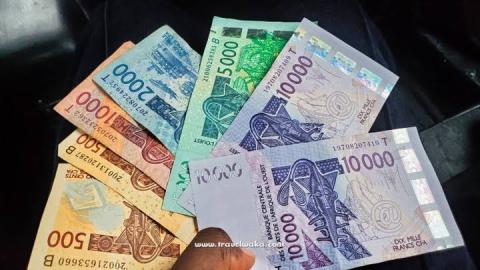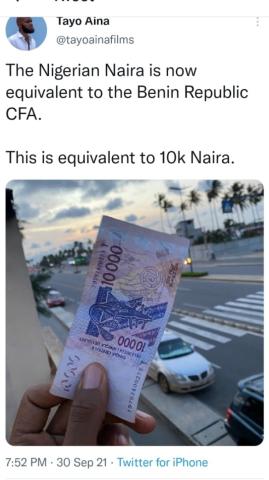
A Twitter user, @tayoainafilms recently made a post on his Twitter handle with a claim that the West African CFA franc is now equivalent to the Nigerian naira.
The CFA franc stands for the West African CFA franc and the Central African CFA franc, two currencies which, though different, are interchangeable and have a fixed exchange rate to the euro.
The Central African CFA is the official currency of six countries under the Central African Economic and Monetary Union and is symbolised by the abbreviation XAF in currency markets.

The countries are Cameroon, Central African Republic, Chad, Republic of the Congo, Equatorial Guinea, and Gabon.
On the other hand, the West African CFA franc is the official currency of eight member nations under the West African Economic and Monetary Union consisting of Benin, Burkina Faso, Côte D’Ivoire, Guinea-Bissau, Mali, Niger, Senegal, and Togo. It is symbolised by the abbreviation XOF in currency markets.
According to a short history on the website of the Central Bank of West African States (BCEAO), the CFA franc was created on December 26, 1945 — remarkably the date France ratified the Bretton Woods Agreements and made its first declaration of parity to the International Monetary Fund (IMF).
Before then, the French colonies used currencies linked to the French franc but after independence, several countries left the franc zone: Tunisia in 1958, Morocco in 1960, Guinea in 1959, Algeria in 1964, Madagascar and Mauritania in 1973.
The International Monetary Fund gave a short history of the devaluation of the CFA.
Goods produced by the CFA franc zone countries were priced out of the world market when the exchange rate for the CFA franc was artificially high.
Partly as a result, these countries’ economies grew little or not at all during the 1980s and early 1990s. To address this situation, they consulted with one another and with the IMF and France, after which they made the bold decision to devalue the CFA franc by 50 per cent.
This meant that as of January 1994, 100 CFA francs equalled 1 French franc, instead of the previous ratio of 50 CFA francs to 1 French franc. The devaluation was aimed at putting these countries back on a path of sustainable growth by helping them regain their competitiveness in the world market.
It encouraged exports at the expense of imports because it enabled CFA franc zone countries to sell their products for half as much but required them to buy products from other countries for twice as much.
However, in 2019, Benin president Patrice Talon made a change in the France-Africa relations when he said Francophone nations in West Africa want to take more control over their CFA franc currency and plan to move some of their reserves away from France. The currency was officially renamed the "Eco."
A Twitter user, @tayoainafilms recently made a post on his Twitter handle with a claim that the West African CFA franc is now equivalent to the Nigerian naira.

The post has since garnered over 2, 800 likes and over a thousand retweets (shares).
This revelation may not be unconnected to the consistent fall in the value of the naira in recent times.
As of October 6, the naira fell marginally against the United States dollar at the official market.
A report by Premium Times quoted data from FMDQ securities exchange window, also known as the Investor and Exporters (I&E) window where forex is officially traded, showed the naira closed at N414.73 per $1.
The fall in naira value has been attributed on several occasions to a move by the Central Bank of Nigeria to stop the sale of foreign exchange to all BDC operators across the country.
On July 27, the CBN ended the sale of forex to BDCs as it stated that operators have become a conduit for illegal financial flows working with corrupt people to conduct money laundering in Nigeria.
The naira fell slightly to the dollar a few hours after the CBN’s announcement. The naira which sold at N503 to one dollar the previous day, crashed further by N2.
On Sunday, the naira exchanged at 410.8 to the US dollar. These figures are, however, not the same at the black market as naira exchanged with the dollar at N573 a few days ago.
Claim: A Twitter user claims the West African CFA Franc is equal to the naira.
Verdict: The claim is false. The CFA is not equal to the naira. However, the value of the naira has crashed over the years against the CFA.
Verification
From checks on official currency exchange websites, Dubawa confirmed that the purchasing power of the naira and CFA are not equal.
On the official market, one naira is equal to 1.38 West African CFA franc which is the official currency in the Benin Republic.
A further check showed that the same rate goes for the Central African CFA franc.
However, the currency had climbed up in value against the naira as 1 naira exchanges for 1.38 XOF compared to 3 XOF which it exchanged for in 2015, six years ago.
Dubawa worked with data available on the website of Exchange Rate UK which shows a 54% decline in the exchange between naira and XAF and XOF within six years.
It showed that on December 10, 2015, the 3 XAF/XOF exchanged at N1.
A report by Guardian stated that the naira had crashed 108% against the CFA within 2015 to 2020 as the latter rallies to wipe out the wide trading gap between the two currencies.
According to the report, in 2015 the CFA began to take a spot as a competitive currency. Between August 2015 and August 2016, the naira lost about 69 per cent against CFA year-on-year.
Conclusion
The claim that the naira is equivalent to the Benin Republic CFA is misleading as official rates show the naira is still slightly higher in value to the CFA. However, the naira was devalued so much with the effect of significantly reducing the normal gap between the two currencies.
The researcher, Elizabeth Ogunbamowo, produced this fact-check per the Dubawa 2021 Kwame KariKari Fellowship partnership with SaharaReporters to facilitate the ethos of “truth” in journalism and enhance media literacy in the country.